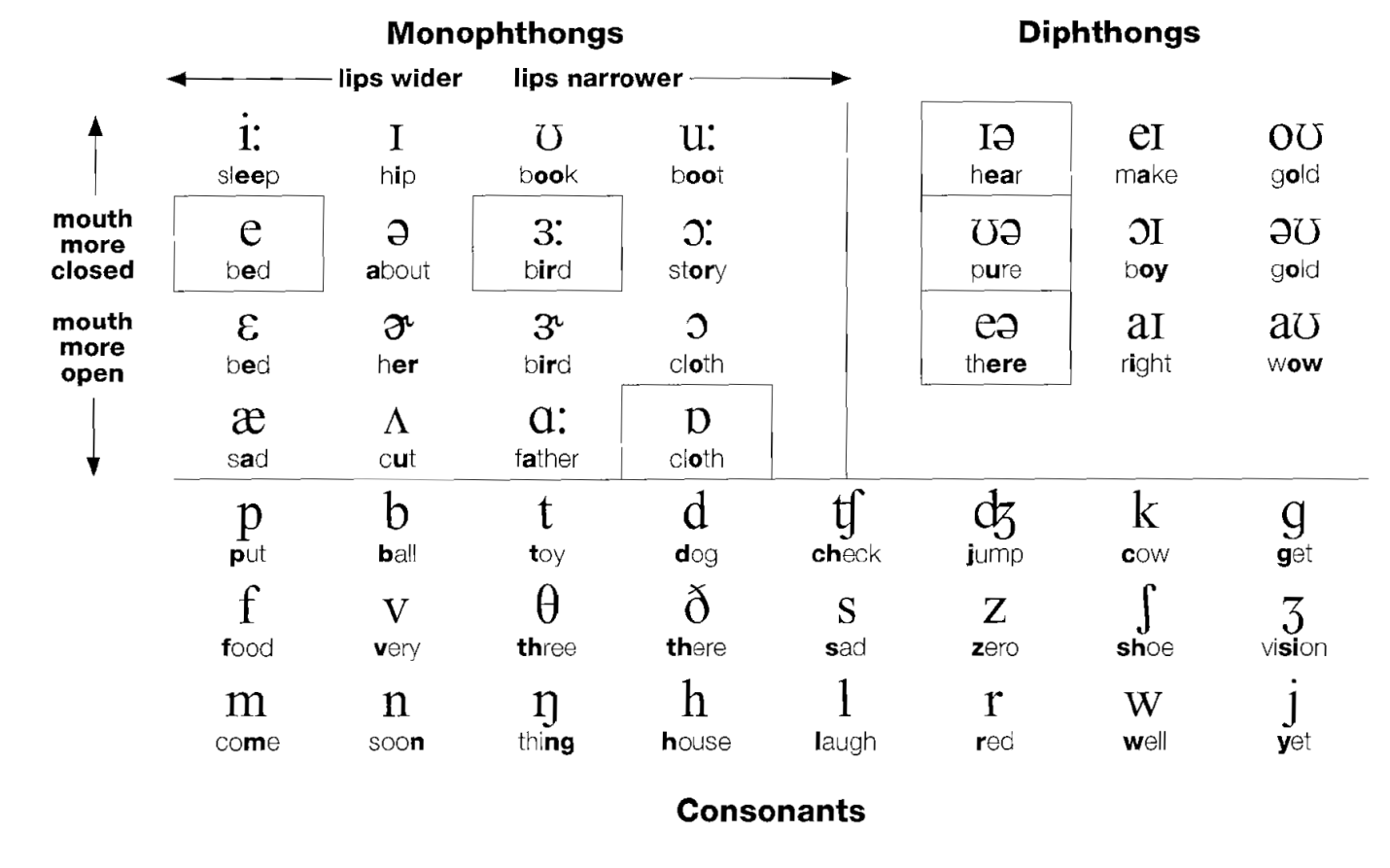Itís Not A Secret Code: The Simple System That Can Help Your Students Achieve Perfect Pronunciation



Each language has its own pronunciation features which will emerge when students speak English. These ‘gaps’ between L1 and English are actually often easy to predict, so that once you receive your class list and can see the nationalities, you can begin preparing pronunciation work which specifically addresses your students’ needs. Below are some of the problems you might expect to hear, including an example minimal pair for each one:
| Chinese: | /ʧ/ and /ʃ/ (catch and cash) ; /f/ and /v/ (few and view) ; /θ/ and /s/ (thing and sing) ; /z/ and /s/ (peas and peace) |
| Arabic: | /p/ and /b/ (pin and bin) ; /g/ and /k/ (bag and back) ; /e/ and /ɪ/ (pet and pit) |
| Spanish: | /p/ and /b/ (pin and bin) ; /d/ and /t/ (road and wrote) ; /g/ and /k/ (bag and back) ; /ʧ/ and /ʃ/ (catch and cash) ; /ɪ/ and /i:/ (ship and sheep) |
| Russian: | /θ/ and /s/ (thing and sing) ; /ð/ and /z/ (clothed and closed) ; /w/ and /v/ (wine and vine) |
| Japanese: | θ/ and /s/ (thing and sing) ; /s/ and /ʃ/ (see and she) ; /r/ and /l/ (road and load) |
When you meet the new class, begin writing down ‘problem words’ and make a list of the sounds which crop up. Very few other languages have the /θ/ sound (‘th’), so that’s often a good place to start.
Create a plan for the week, or the semester, which integrates pronunciation work. Include specific targets and sounds so that progress can be measured. I tackle one or two consonant sounds, and one vowel sound, each week, depending on the class. In all, I spend perhaps 10% of my class time working on pronunciation specifically, but I’m always listening for the target sounds during pairwork and presentations, offering corrections where needed.
A critical step in improving pronunciation is to encourage the students to listen to themselves. Making recordings of their speaking, especially early in the learning process, can be extremely beneficial. As the students become more aware of their pronunciation issues, they tend to self-correct, and to correct each other, rather than needing the teacher to do so. Also, improving those specific sounds becomes a shared objective, something around which the class can unite.
Humor is a terrific aid to pronunciation work. Making light of a problem makes the solution more memorable and makes it less likely that shy students will clam up and avoid practicing the difficult sound. One of my favorite methods for teaching /θ/ is to pretend that I’m pulling the students’ tongue out like I’m pulling a climber up a cliff face with a rope.
Ask the students to make lists of words which include the target sounds. This raises their awareness of the contexts in which the sound can be found, and provides practice material. This is also a good way to start the process of constructing tongue-twisters; there are thousands online, but I like asking the students to make their own.
The week after I teach the sound, we review using tongue-twisters, funny dialogues which focus on that sound, or a jeopardy-style game. I do the same thing three weeks after teaching the sound. This way, the work is reinforced and the students are less likely to slide back into bad habits.
Monitor for the target sounds throughout your class, and not only in the pronunciation section. Reinforcement like this is very positive, as it contextualizes the sound. Point out minimal pair issues – occasions where the pronunciation issue actually causes the production of a different word – and make light of these, especially when they have comic potential (as they often do!)
A colleague approached me one day looking rather perplexed. “My student gave me this and asked for my opinion.” He showed me the page and confessed, “I really don’t know what this is. I think it might be Ewok.”
Rather than a visitation from furry forest creatures, this was merely a sentence in the International Phonetic Alphabet. The IPA is a terrific system for writing down the sounds of words. It relies on an alphabet which is actually very familiar, but features a few new characters. In my experience, an hour of practice with this system is enough to gain fluency, and once gained, you’ll have it for life.
It has many versions, but the most common IPA now in use for English looks like this:

The benefits of learning the IPA are many, and richly reward the time and effort spent on learning and teaching it.
Anyone who has learned English has despaired of our spelling system. Why should ‘bought’ and ‘sort’ have the same vowel sound? Or ‘Phil’ and ‘fill’ begin with the same consonant sound?
Learning the IPA removes spelling as a barrier, and invites students to consider the variety of spellings each sound might have.
Most good-quality dictionaries include the IPA for each word. Your students will be able to read the IPA and pronounce the word without much help at all. The best dictionaries also include hints on emphasis.
When teaching a new word, I’ve found it helpful give examples, rooted in the IPA, to which the new word’s sound can be compared. For example, when we learned the sound /ʧ/ I used ‘church’, as it contains two of these sounds. Whenever the sound cropped up, there was a ready point of comparison: “It’s the ‘ch’ from ‘church’, remember?” This can also be used to clear up confusion between two vowel or diphthong sounds: “It’s the /eɪ/ from ‘pay’, not the /eə/ from ‘pair’”.
Breaking up words into their constituent phonemes gives students the chance to consider each phonemic ‘piece’ separately, which provides real insight into how words are constructed. Each sound also becomes standardized, removing much of the mystery from pronunciation.
IPA games are a great way to review the system itself, and to focus attention on pronunciation. I’ve done Jeopardy-style games with the IPA, offering three or four levels of difficulty (and therefore reward). Either the teacher writes the word in the IPA and the students have to puzzle it out (and perhaps offer a definition, possible etymology and usage) or the students must write down the IPA in the form of a dictation. Both are extremely valuable practice. Putting a time limit on it adds useful pressure, and it’s always interesting to see IPA words being constructed as part of teamwork.